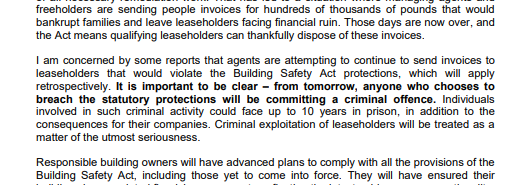I’ve been covering the plight of leaseholders caught up in the cladding scandal for 3years now but the tale below is definitely up there with one of the most shocking I have seen.
Highlights just how ridiculous the building safety crisis has become… insidehousing.co.uk/news/housing-a…
Highlights just how ridiculous the building safety crisis has become… insidehousing.co.uk/news/housing-a…
First and foremost, the £101,500 bill is one of the biggest there is.
It's even more eyewatering when you consider that many of the leaseholders and shared owners paid well below the sum when purchasing their properties
It's even more eyewatering when you consider that many of the leaseholders and shared owners paid well below the sum when purchasing their properties

One leaseholder for example says he paid £88k to buy his flat outright several years ago.
Absurd that he will now be billed more than that for remedial works for a building he was assured met regulations at the time of purchase.
Absurd that he will now be billed more than that for remedial works for a building he was assured met regulations at the time of purchase.
Even more ironic is the fact that the owner of Transport House is a registered provider of social housing. When these flats were originally sold, they were aimed at providing affordable homeownership for key workers unable to get on the property ladder. 

There is a lot of discussion around the definition of affordable housing, but I can safely say this isn't one of them:
‘Buy a portion of a house for around £60k. Live in it for 10 years and then be hit with a remedial bill that is nearly double what you originally paid'
‘Buy a portion of a house for around £60k. Live in it for 10 years and then be hit with a remedial bill that is nearly double what you originally paid'
This is the situation for one leaseholder who bought his property when he was teaching back in 2005. He says at the time there was a stringent vetting process to ensure that key workers and those most in need could purchase a share of the flat. 

And this is where the building safety scandal has really exposed the issues with the shared ownership model. Paying 100% service charges for the upkeep of a flat you only own half of seems unfair, but when you factor in a huge £100k fire safety bill, it becomes farcical. 

Some might think that as homeowners, those hit by the cladding scandal may have the money to cover costs. This is completely false. Just look at the below example, Matt would have to work for five years and spend no other money, to cover his bill.
I mean, what the actual?
I mean, what the actual?

The leaseholders have nowehere to turn.
They are legally obliged to pay the bill (isn’t leasehold law fair, eh?) and they have no access to government funding. This is because despite their building being “unsuitable and unsafe”, it is too small to qualify for the government pot
They are legally obliged to pay the bill (isn’t leasehold law fair, eh?) and they have no access to government funding. This is because despite their building being “unsuitable and unsafe”, it is too small to qualify for the government pot

But never fear, there is a loan system on its way. My fag packet calculations (maths never a strong point) mean that a £50-a-month payment, would mean that Transport House leaseholders could be paying this every month for the next 169 years. How is that feasible?
Well, we think that is how it works anyway, the gov hasn’t really provided much detail on this loan system since it put it forward as a way to 'end unsafe cladding' in February (nearly four months ago) gov.uk/government/new…
Like with all of these stories, it is the leaseholder or shared owner that has their lives ruined. The below is a sentiment I've heard from many leaseholders.
They see horrible things like this happening to 'other people', and then, all of a sudden, they are the 'other people'
They see horrible things like this happening to 'other people', and then, all of a sudden, they are the 'other people'

Transport House is like so many others.
No normal person is able to find £100k, never mind shared owners who bought this housing because it was affordable.
If the work needs to be done and leaseholders must pay, the only outcome will be mass bankruptcies and repossessions.
No normal person is able to find £100k, never mind shared owners who bought this housing because it was affordable.
If the work needs to be done and leaseholders must pay, the only outcome will be mass bankruptcies and repossessions.
• • •
Missing some Tweet in this thread? You can try to
force a refresh







